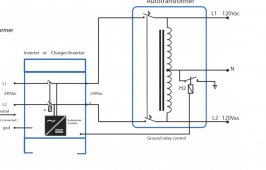I’m sorry but I used many auto transformers and under normal non fault conditions current does not flow in the PE wire. If it did all my RCBOs would trip.
Yes, RCBO would trip if the circuit caused such ground current (30 mA for typical European whole-house protector, 5 mA for U.S. branch circuit.)
Do you have RCBO on a source that has neutral, is feeding an auto-transformer with center-tap grounded, and has unbalanced load?
If you really are concerned about this then a galvanically isolated split phase output put transformer can be easily sourced , ie 240 to 240 centre tap , this guarantees no current can possibly flow in the ground line, except under equipment failure conditions
Yes, that is what several of us have been telling people to do if they really want to use a 240V single-phase inverter between U.S. split-phase grid and loads.
Something is wrong here. Current returns to the source not via the neutral PE bond
Current returns to its source, follows a loop.
As shown in the schematic, source was +/-170Vpeak (120Vrms), midpoint grounded. That represents utility grid. In reality that is the secondary of utility transformer, and center tap neutral is grounded at my house. From there, neutral is wired to loads, and ground is wired to chassis of loads. The fact there is a ground rod has nothing to do with where current flows, because it is a single-point ground. (Same in the SPICE schematic, only one ground symbol so no current flows into it, but SPICE requires a DC path from all nodes to ground.)
Without auto-transformer, current from the utility source Line2 would flow through Rload and back through Neutral to the source. That's if you connected Neutral. If you instead connect ground to Rload, current flows back through ground.
With auto-transformer, there are two ways for current exiting Rload to get back to source. From what you say, your derived_neutral from auto-transformer (where load is connected) has a ground wire back to utility, and that ground wire is bonded to utility neutral. That is one resistive path. A second path is through the auto-transformer to L1. Auto-transformer tries to have equal current flowing through windings connected to L1 and L2.
But not in same direction! The currents flow in opposite directions. To have 7Apeak flow in resistive load, 3.5Apeak flows from L1 through winding then through derived neutral and into Rload. Another 3.5A peak flows from L2 (in the opposite direction voltage of L2 wants to push current) through L2 and adds another 3.5A in derived neutral (for a total of 7A in derived neutral) and through Rload. L1 and L2 each supply 3.5A from utility, but 7A flows in Rload.
That's if there is no other way for current to get back from derived_neutral to utility neutral. But you've connected ground wire (which will happily carry 100% of current.) Current splits according to impedance. In my SPICE deck, about half went through ground wire and half through center-tap of transformer. On the bench, with a small auto-transformer having higher resistance skinny wires, 90% went through ground and 10% through auto-transformer center tap.
Current will return to source but if a parallel path is provided, objectionable current will flow on a ground equal to 1/2 the total neutral current. It has nothing to do with "normal return is not available". If there is a parallel path, 1/2 the current will flow on each wire.
Half the current if both wires of same impedance. If your Romex has 12 awg neutral and 12 awg ground, it would be about half.
With my auto-transformer, the house wiring had much lower resistance back to utility than the winding resistance, because the transformer was only a few hundred VA. With L1, L2, Ground wires from grid, 122V reached load, but with L1, L2, and only auto-transformer to create a derived neutral, 117V reached load. That was 5Vrms drop with 7A peak (5A rms) so something like 1 ohm in windings.
We’re you using a auto transformer or sn isolating transformer.
My bench test and the SPICE schematic I showed are equivalent, except the transformer on the bench was smaller.
It had a number of windings, and I connected identical windings in series to have a center-tapped auto-transformer.
(I left one winding isolated, and capped a number of un-used taps.)
Every isolation transformer with split-phase output will also act as an auto-transformer; when you backfeed utility with 240V from GT PV, if you (or neighbors sharing secondary) have a 120V load, the utility transformer's secondary windings derive a neutral and carry the power. Usually that doesn't cause an issue, but I've figured out the "120% rule" for GT PV breakers provides some protection against overloading that neutral.
I did an experiment. Now you do one. With only loads you can risk subjecting to incorrect voltage applied ...
With an imbalanced load (like my oil-filled radiator on one phase)
1) Measure current through center tap, and current through ground wire back to utility.
2) Disconnect auto-transformer and measure voltage across load, also current through ground wire back to utility.
Do you have a "ground" wire bonded to neutral somewhere around utility connection, as shown in my schematic? Does that ground wire also connect to both center tap of auto-transformer and to neutral of loads? If so, do you agree that without auto-transformer, current has to flow in your ground wire?




